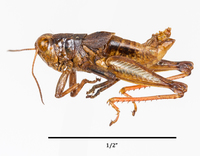| |
Family (Alpha): | |
| View | Acrididae Members:
| NC Records |
|---|
Melanoplus divergens Morse, 1904 - Divergent Melanoplus |
 |
|
|
|
|
|
Image Gallery for Melanoplus divergens - Divergent Melanoplus
|
 | Recorded by: B.B. Fulton
Jackson Co.
Comment: NCSU specimen |  | Recorded by: B.B. Fulton
Haywood Co.
Comment: NCSU specimen |
|